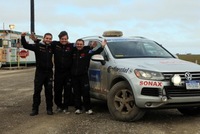Argentina to Alaska In A Volkswagen Toureg TDI
VW TOUREG TDI SETS PAN-AMERICAN HIGHWAY RECORD
Argentina to Alaska in less than 12 days
By Steve Purdy
TheAutoChannel.com
Detroit Bureau
German adventurer Rainer Zietlow and his two accomplices, Juan Carlos of Spain and fellow German Marius Biela, drove their Volkswagen Touareg TDI Clean Diesel SUV from the tip of South America along the 1,600-mile length of the Pan-American Highway to the end of the road in northern Alaska from July 2nd to the 13th, setting a new world record of just less than 12 days. The impetus for the record run was to celebrate road’s 75th anniversary and to demonstrate the competence of the turbo-diesel Touareg.
After nearly two years of careful planning and preparation, the team flew to Buenos Aires where they picked up their essentially stock Touareg TDI for the trip. The only modifications done for the challenge were the installation of an auxiliary 300-lieter fuel tank, adding the largest wheels and tires that would fit the Touareg and mounting an Inmarsat satellite communications system. Making over 400 pound-feet of torque, having enough room for three adventurers and their gear, and being capable of highway mileage just short of 30-mpg, the Touareg promised to be an ideal vehicle for the trip.
 |
In order to allow fans and sponsors to monitor the run the team blogged along the way using their military-style indestructible laptop computer from Getac, the same company that provides these systems to the military. In addition to Volkswagen, other sponsors joining the project were: 3M providing a new, flexible, lead-free wheel weights along with a protective film for the Touareg’s leading edge; Continental providing tires; Bosch whose fuel delivery and other systems are part of the Touareg; Kuehne+Nagel who handled the complex and touchy logistics; Allianz Global Automotive for insurance; OEM supplier Federal Mogul; SONAX car care products company; Exide Technologies battery company; Castrol who provided lubricants; ESL mobile communications company; Imnarsat satellite communications company; Kruse who manufactures the AdBlue urea for the diesel exhaust treatment; PIAA auxiliary lighting provider; and TAG Heuer who provided the official timing equipment.
 |
Starting from cold, snowy Ushuaia they sped north virtually non-stop through surprisingly little adversity. Near Santiago, Chile the road crosses the mighty Andes then heads up the Pacific Coast as far as Ecuador. There the road eases away from coast and heads into the mountains, through the jungles finally to the Caribbean port city of Cartegena, Colombia where they had to board a cargo plane to Panama City. No one has yet found a way to build the road through the rain forests of the southern Isthmus of Panama and northern Colombia called the Darien Gap.
 |
With only minimal weather and traffic issues, and logistics that went off without a hitch the team in the Touareg began to get excited enough to mitigate their fatigue as they began to realize that, barring any unforeseen crises, the record would shortly be theirs.
And it was – they beat the old record by about three days.
Through sandstorms and muddy roads, endless deserts and 10,000-foot mountain passes, along spectacular coastlines and barren plains, the Touareg team drove night and day to set that record.
There was a time when this reporter lusted after such adventures. In fact, seven nearly non-stop trips around the U.S. on the endurance rallies called Cannonball One Lap of America will support that contention. One of our One Lap pals, professional endurance driver Garry Sowerby, had driven the Pan-American Highway in 24 days. That was in the middle 1980s. They spent perhaps a third of their time negotiating their way across the borders.
To Rainer Zietlow and his team we say, “Well done, indeed!”
© Steve Purdy, Shunpiker Productions, All Rights Reserved



